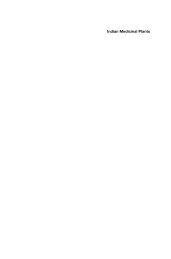a-collection-of-research-articles-on-the-medical-potential-of-cow-urine
a-collection-of-research-articles-on-the-medical-potential-of-cow-urine
a-collection-of-research-articles-on-the-medical-potential-of-cow-urine
Create successful ePaper yourself
Turn your PDF publications into a flip-book with our unique Google optimized e-Paper software.
1972 Mol Biol Rep (2014) 41:1967–1976<br />
17.08, and 11.95 % respectively, in <strong>the</strong> levels <str<strong>on</strong>g>of</str<strong>on</strong>g> total<br />
protein as compared to lindane group. The best results were<br />
shown by <strong>the</strong> pretreatment <str<strong>on</strong>g>of</str<strong>on</strong>g> combinati<strong>on</strong> <str<strong>on</strong>g>of</str<strong>on</strong>g> antioxidants<br />
which resulted in about 20.00 % rise in <strong>the</strong> total protein<br />
levels which had decreased to 15.01 % after lindane<br />
intoxicati<strong>on</strong>. The increasing order <str<strong>on</strong>g>of</str<strong>on</strong>g> protein levels in<br />
various groups is as follows: L \ U?A?L \ U?A \ U?<br />
L \ C \ A?L \ U \ A.<br />
Effect <strong>on</strong> endogenous vitamin E (Graph 7)<br />
A significant decrease (P \ 0.01) <str<strong>on</strong>g>of</str<strong>on</strong>g> 34.94 % was registered<br />
in <strong>the</strong> endogenous levels <str<strong>on</strong>g>of</str<strong>on</strong>g> vitamin E in lindane<br />
group as compared to c<strong>on</strong>trol. A?L, U?L and U?A?L<br />
groups significantly (P \ 0.01) alleviated <strong>the</strong> levels <str<strong>on</strong>g>of</str<strong>on</strong>g><br />
vitamin E by 86.65, 47.30, and 92.32 %, respectively in<br />
comparis<strong>on</strong> to lindane group. The increasing order <str<strong>on</strong>g>of</str<strong>on</strong>g><br />
vitamin E levels in all <strong>the</strong> groups was as follow:<br />
L \ U?L \ C \ U \ A?L \ U?A?L \ A \ U?A.<br />
Effect <strong>on</strong> endogenous vitamin C (Graph 8)<br />
As compared to c<strong>on</strong>trol, a significant decrease (P \ 0.01)<br />
<str<strong>on</strong>g>of</str<strong>on</strong>g> 50.95 % was observed in <strong>the</strong> endogenous levels <str<strong>on</strong>g>of</str<strong>on</strong>g><br />
vitamin C in animals toxicated with lindane. This decrease<br />
was alleviated significantly (P \ 0.01) when <strong>the</strong> different<br />
pretreatments were given. In comparis<strong>on</strong> to lindane treated<br />
animals, <strong>the</strong> animals <str<strong>on</strong>g>of</str<strong>on</strong>g> A?L, U?L and U?A?L group<br />
showed an increase <str<strong>on</strong>g>of</str<strong>on</strong>g> 140.95, 100.51, and 107.18 %,<br />
respectively. The increasing order <str<strong>on</strong>g>of</str<strong>on</strong>g> <strong>the</strong> vitamin C levels<br />
in all <strong>the</strong> eight groups was as follow: L \ U?L \ C \<br />
U?A?L\ A?L \ U \ U?A \ A.<br />
Discussi<strong>on</strong><br />
The results <str<strong>on</strong>g>of</str<strong>on</strong>g> <strong>the</strong> present study clearly dem<strong>on</strong>strate that<br />
LPO significantly increased in kidney after in vivo treatment<br />
<str<strong>on</strong>g>of</str<strong>on</strong>g> lindane. Thus, results <str<strong>on</strong>g>of</str<strong>on</strong>g> <strong>the</strong> present study are in<br />
agreement with previous reports where increase in LPO<br />
was also observed due to lindane in different tissues [11,<br />
22, 42, 48, 67]. Moreover, renal LPO levels also increase<br />
due to aflatoxin [61], CCl 4 [7], chlorpryfos-ethyl [46], lead<br />
[55], cisplatin [4] and gentamicin [1] toxicity. The increase<br />
in LPO results owing to increase in ROS or alternatively<br />
lindane might inhibit antioxidant molecules and antioxidant<br />
enzymes. The support for such an assumpti<strong>on</strong> comes<br />
from <strong>the</strong> findings that lindane reduces antioxidant molecules<br />
and antioxidant enzymes [8, 42, 48] which is also<br />
observed in <strong>the</strong> present study.<br />
The pretreatment with vitamin C, E, lipoic acid and <strong>cow</strong><br />
<strong>urine</strong> in <strong>the</strong> groups A?L, U?L and U?A?L significantly<br />
lowered <strong>the</strong> LPO levels as compared to mice treated with<br />
lindane al<strong>on</strong>e. Earlier reports have also shown that supplementati<strong>on</strong><br />
with vitamin C and E attenuated <strong>the</strong> LPO<br />
levels decreased due to cisplatin [4] and chlorpyrifos [46].<br />
Lipoic acid also ameliorates renal oxidative stress [6].<br />
Moreover, combinati<strong>on</strong> <str<strong>on</strong>g>of</str<strong>on</strong>g> lipoic acid and vitamin E [11],<br />
vitamin C, E, lipoic acid and resveratrol [8] and vitamin C,<br />
E and lipoic acid [42] ameliorated <strong>the</strong> lindane induced<br />
increased LPO levels.<br />
The results reveal that <strong>the</strong> pretreatment <str<strong>on</strong>g>of</str<strong>on</strong>g> combinati<strong>on</strong><br />
<str<strong>on</strong>g>of</str<strong>on</strong>g> antioxidants and <strong>cow</strong> <strong>urine</strong> (U?A?L) was <strong>the</strong> most<br />
effective in lowering <strong>the</strong> LPO levels followed by combinati<strong>on</strong><br />
<str<strong>on</strong>g>of</str<strong>on</strong>g> antioxidant (A?L) and <strong>cow</strong> <strong>urine</strong> pretreatment<br />
(U?L).<br />
Due to increase in LPO <strong>the</strong> amount <str<strong>on</strong>g>of</str<strong>on</strong>g> free radicals<br />
crosses <strong>the</strong> threshold level. Never<strong>the</strong>less, decrease in <strong>the</strong><br />
activities <str<strong>on</strong>g>of</str<strong>on</strong>g> CAT, SOD, GPx and GSH fur<strong>the</strong>r deteriorates<br />
<strong>the</strong> situati<strong>on</strong> and enhance <strong>the</strong> formati<strong>on</strong> <str<strong>on</strong>g>of</str<strong>on</strong>g> lipid peroxides.<br />
It could be assumed that lindane might have caused LPO<br />
by inhibiting <strong>the</strong> antioxidant enzymes, molecule, vitamin E<br />
and C. The mechanism by which lindane induces oxidative<br />
stress involves <strong>the</strong> activity <str<strong>on</strong>g>of</str<strong>on</strong>g> cyt P450 system resulting in<br />
<strong>the</strong> generati<strong>on</strong> <str<strong>on</strong>g>of</str<strong>on</strong>g> superoxide radicals [21].<br />
Similar to earlier reports, results <str<strong>on</strong>g>of</str<strong>on</strong>g> <strong>the</strong> present study<br />
also show a decrease in SOD and CAT levels in <strong>the</strong> lindane<br />
treated group and in all such cases <strong>the</strong> main culprit being<br />
superoxide radicals [9, 42, 48]. Renal SOD and CAT levels<br />
were also lowered due to chlorpryfos-ethyl [46], aflatoxin<br />
[61], CCl 4 [7], lead [55], cisplatin [4], alcohol [60] and<br />
gentamicin [1] toxicity.<br />
The decreased activity <str<strong>on</strong>g>of</str<strong>on</strong>g> SOD in kidney in lindane<br />
treated mice may be due to <strong>the</strong> enhanced lipid peroxidati<strong>on</strong><br />
or inactivati<strong>on</strong> <str<strong>on</strong>g>of</str<strong>on</strong>g> <strong>the</strong> antioxidative enzymes or<br />
could result from inactivati<strong>on</strong> by hydrogen peroxide or<br />
glycati<strong>on</strong> <str<strong>on</strong>g>of</str<strong>on</strong>g> <strong>the</strong> enzyme [62]. This would cause an<br />
increased accumulati<strong>on</strong> <str<strong>on</strong>g>of</str<strong>on</strong>g> superoxide radicals, which<br />
could fur<strong>the</strong>r stimulate lipid peroxidati<strong>on</strong>. A decrease in<br />
SOD activity favors <strong>the</strong> accumulati<strong>on</strong> <str<strong>on</strong>g>of</str<strong>on</strong>g> superoxide<br />
radicals,whichinturn inhibit CAT [33] asalsoseenin<br />
<strong>the</strong> present study.<br />
All <strong>the</strong> pretreatment groups showed alleviati<strong>on</strong> in <strong>the</strong><br />
levels <str<strong>on</strong>g>of</str<strong>on</strong>g> SOD and CAT. Earlier reports have shown that<br />
vitamin C and E are capable <str<strong>on</strong>g>of</str<strong>on</strong>g> increasing <strong>the</strong> renal SOD<br />
and CAT levels [4, 7, 46]. Combinati<strong>on</strong> <str<strong>on</strong>g>of</str<strong>on</strong>g> lipoic acid,<br />
vitamin C, E and resveratrol [9] and lipoic acid and vitamin<br />
C and E [42] attenuated <strong>the</strong> SOD and CAT levels in brain<br />
and testis, respectively <str<strong>on</strong>g>of</str<strong>on</strong>g> lindane treated mice. Am<strong>on</strong>gst<br />
<strong>the</strong> three pretreatments <strong>the</strong> maximum ameliorati<strong>on</strong> in <strong>the</strong><br />
levels <str<strong>on</strong>g>of</str<strong>on</strong>g> SOD was observed in case <str<strong>on</strong>g>of</str<strong>on</strong>g> U?A?L group<br />
followed by U?L group and was least in A?L group.<br />
Moreover, in <strong>the</strong> present study <strong>the</strong> protecti<strong>on</strong> <str<strong>on</strong>g>of</str<strong>on</strong>g>fered<br />
by combinati<strong>on</strong> <str<strong>on</strong>g>of</str<strong>on</strong>g> antioxidants (A?L group) in ameliorating<br />
<strong>the</strong> CAT levels was <strong>the</strong> maximum followed by<br />
123









